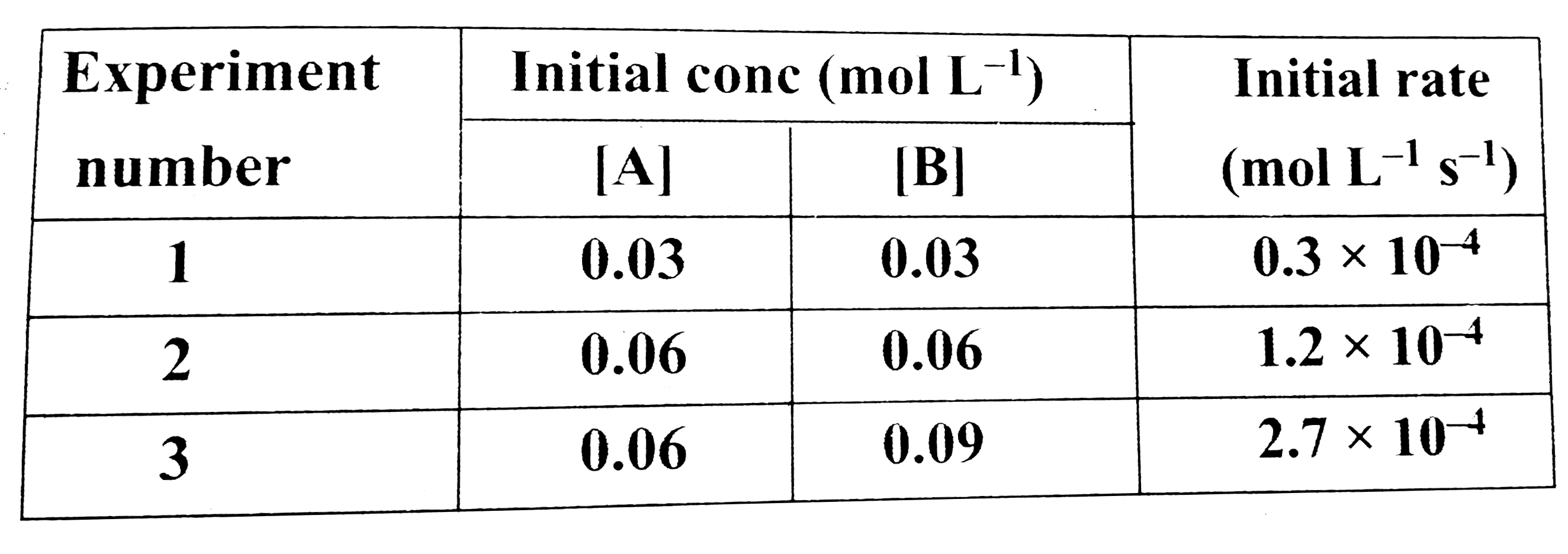For the non-stoichiometric reaction 2A+B→C+D, The following data were obtained in three separate experiments, all at 298 K.

The rate law for the formation of C is:
dcdt=k[A]
dcdt=k[A][B]
dcdt=k[A]2[B]
dcdt=k[A][B]2
The correct Answer is:A
First order w.r.t. A and zero order w.r.t. B
∴ dcdt=k[A]
Topper's Solved these Questions
- BOOK - VMC MODULES ENGLISHCHAPTER - CHEMICAL KINETICS EXERCISE - JEE Advanced (Archive)52videos
CHEMICAL KINETICS
- BOOK - VMC MODULES ENGLISHCHAPTER - CHEMICAL KINETICS EXERCISE - Level-2 ( Numerical Value Type for JEE Main )15videos
CHEMICAL KINETICS
- BOOK - VMC MODULES ENGLISHCHAPTER - CHEMICAL EQUILIBRIUMEXERCISE - IN-CHAPTER EXERCISE - G10videos
CHEMICAL EQUILIBRIUM
- BOOK - VMC MODULES ENGLISHCHAPTER - CHEMICAL THERMODYNAMICS EXERCISE - IN - CHAPTER EXERCISE - L10videos
CHEMICAL THERMODYNAMICS
Similar Questions
For the non-stoichiometric reaction 2A+B→C+D
The following kinetic data were obtained in theee separate experiment, all at 98K
∣∣ ∣ ∣ ∣ ∣∣Initial concentration (A)Initial concentration (B)Initial rate of formation of C(molL−1s−1)0.01M0.1M1.2×10−30.1M0.2M1.2×10−30.2M0.1M2.4×10−3∣∣ ∣ ∣ ∣ ∣∣
The rate law for the formation of C is:View SolutionFor the reaction A→B+C, the following data were obtained

find the order of the reaction .View SolutionFor the reaction A→B+C, the following data were obtained

find the order of the reaction .View SolutionFor the reaction A→B+C, the following data were obtained

find the order of the reaction .View SolutionFor the reaction, 2A+B→3C+D, which of the following does not express the reaction rate
View Solutionfor the reaction, 2A+B→3C+D, which of the following does not express the reaction rate
View SolutionFor the reaction A+B→C. The following data were obtained. In the first experiment, when the initial concentrations of both A and B are 0.1M, the observed initial rate of formation of C is 1×10−4mollitre−1minute−1. In the second experiment when the initial concentrations of A and B are 0.1M and 0.3M, the initial rate is 9.0×10−4molliter−1minute−1. In the third experiment when the initial concentrations of both A and B are 0.3M the initial rate is 2.7×10−3mollitre−1minute−1.
(a) Write rate law for this reaction.
(b) Calculate the value of specific rate constant for this reaction.View Solutionform the gaseous reaction
2A+B2→2AB, the following rate data were obtained at 300K.

Calculate the rate constant for the reaction and the rate of formation of AB when [A] is 0.02 and [B2] is 0.04molL−1 at 300K.View Solutionform the gaseous reaction
2A+B2→2AB, the following rate data were obtained at 300K.

Calculate the rate constant for the reaction and the rate of formation of AB when [A] is 0.02 and [B2] is 0.04molL−1 at 300K.View SolutionFor a reaction in which A and B form C, the following data were obtained form theee experiments:

What is the rate equation of the equation and what is the value of rate constant ?View Solution

